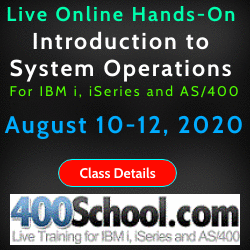
|
||
|
SecureMyi.com Security and Systems Management Newsletter for the IBM i
March 13, 2013 - Vol 3, Issue 25
|
||

|
||

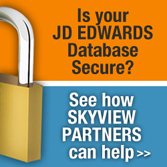
|
Feature Article
By Dan Riehl Unless you have changed your network server startup defaults, a lot of network servers are starting on your system that you have no earthly need to run. Running servers that are not needed opens up additional network pathways to your system that results in increased vulnerability. For example, why turn your IBM i into a mail server by starting POP3 and/or SMTP when your system will never process any e-mail? But, unless you have changed the IBM defaults, your system is running the servers to process email. The IBM shipped defaults will automatically start a large number of servers when you start the Host servers and TCP/IP servers. Here is a list of the servers that are set to automatically start in IBM i 6.1. Along with the servers that are automatically started, numerous server related clients and daemons are set to start when particular servers start. Information on each IBM i 6.1 server, including server names, associated jobs and auto-start settings can be found here at the IBM i 6.1 Information Center. Stark Terror when Starting and Ending TCP/IP serversThe IBM supplied default values when starting a TCP/IP server will cause all TCP/IP servers to attempt to start. That is one of the main problems we have in controlling the start of these servers. A well-meaning IT Staff member types "STRTCPSVR" and presses ENTER… All the TCP/IP servers will attempt to start. The STRTCPSVR(Start TCP/IP Server) command's default value of SERVER(*ALL) is not appropriate. It runs the command as shown here. STRTCPSVR SERVER(*ALL) But, you can change this terrorizing default behavior, and help protect your system. |
|
In This Issue
Quick Links
Our Newsletter Sponsors
Platinum Sponsor |
IBM i Security ResourcesJohn Earl Memorial Tribute - Jan 2013 IBM i Security Videos from SecureMyi.com SecureMyi Newsletter Home and ArchivesSearch Security Site for IBM i and i5/OS IBM i Security Reference - IBM i 6.1 IBM i Security Reference - IBM i 7.1 QAUDJRN Audit Types By AUDLVL 6.1 QAUDJRN Entry Type Record Layout 6.1 RedBook - Security Guide for IBM i 6.1 PCI SSC Data Security Standards 


|


|

|
||
IBM i Security and Systems Management News BytesPowerTech Adds New Auditing Capabilities in Authority Broker 4.0PowerTech, a Help/Systems company, has announced a new version of their Authority Broker software that adds a Screen-Cam capability to audit user activity when using System Service Tools(SST), QSH, and other "Invisible" green screen based activity. While the IBM i security infrastructure includes auditing capabilities for green screen commands, Authority Broker 4.0 extends IBM i auditing into non-command-based environments, including STRSQL, DFU, QSHELL, and System Service Tools (SST). See more about the new version of Authority Broker. IBM i Security Calendar of Events
|
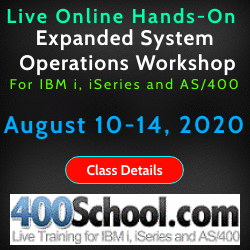

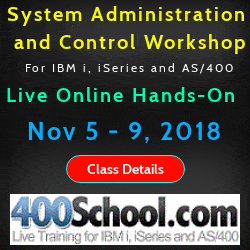
|
|
Security Shorts -
By Dan Riehl Have you ever used the WRKREGINF command? It is the IBM i command to Work with Registration Information. So, you ask, "What is Registration Information anyway?" Simply put, it is the registered exit points and exit programs that allow IBM, third party vendors and you to do some custom processing when an event occurs on your system. For example, IBM provides a registered exit point for the process of creating a user profile. It allows you to do some custom processing when a user profile is created. You accomplish your custom processing by writing a program, and registering the program using the WRKREGINF command or the ADDEXITPGM(Add Exit Program) command. There are many categories of exit points. Some are for Backup and Recovery, User Profile maintenance, Network Access(Like FTP and ODBC), and many others. Thankfully, the ability to add an exit program to the registry is restricted to a user with Security Officer access. I say thankfully, because it is possible through adding exit programs to override or complement the normal functioning of the system. That’s what the exit points were designed for. Now, please let me take you a step furtherSeveral OS releases ago, IBM provided us with the capability to add exit programs to Control Language commands. These are referred to as Command Exit programs. So, if you wanted to add your own custom logic to a CL command, you could do that through registering your own custom written program to the IBM supplied exit points named QIBM_QCA_CHG_COMMAND and QIBM_QCA_RTV_COMMAND. For information on using these CL Command exit points, see the two part series at Securemyi.com. Please, just one more step with meWhen installing third party vendor supplied packages you are often required to log-on to the system as QSECOFR, or similar powerful user profile. This, in itself, is not a bad thing. But, do you know what the vendor's install process is doing to your system? I was recently at a customer site performing a security assessment and was running a standard audit report from my toolkit and discovered a little surprise deposited by a third party vendor’s install process. The vendor had added an exit program for the IBM supplied Control Language command APYPTF(Apply Program Temporary Fix). I was puzzled. Why would a well-respected software vendor want to hook their own logic into the PTF process, especially when the software product itself had absolutely NO relationship to system fixes or PTFs? I called the vendor and questioned them about what this exit program was doing there. The vendor did not provide any kind of reasonable answer, and advised me that it was ok to remove the exit program if I wanted to, it would not affect their application. So why was it there in the first place? Hmmmm - very fishy. So, What can I do?You can review all the exit programs on your system by using the WRKREGINF command, and paging through all the screens, or you can print a report using the same command. You will find that the printed report is a bit complex, but look for exit programs, especially those in non-IBM supplied libraries. Make sure you know what the Non-IBM exit programs are, and why they are there. I want to suggest something that may increase your comfort level when installing new software. Start the IBM i auditing function for the user doing the install, to include auditing command execution and system changes. When the install is complete, run some QAUDJRN auditing reports to see exactly what happened during the install process. Here’s a command to start auditing a user’s actions before you start the install process.
CHGUSRAUD USRPRF(MYUSER) +
AUDLVL(*CMD *CREATE *SYSMGT *SERVICE *SAVRST *SECURITY *OBJMGT)
(Note: If you are auditing some of these events at the system level(i.e. in the QAUDLVL system value, you do not need to include them at the User level. But you will want to include at least *CMD, since that cannot be specified at the system level. It will provide an audit trail of every CL command executed by that user.) And for detailed information on auditing changes to the Exit Point Registry, see the February 27, 2013 issue of the SecureMyi Security and Systems Management Newsletter in the article Auditing Exit Point Changes. |
Sponsored Links
IBM i, iSeries and AS/400
|
|
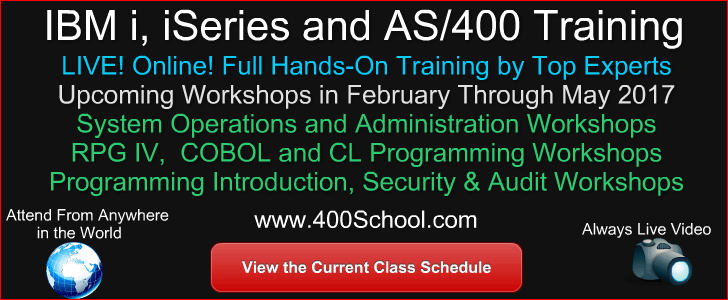
|
||
|
Send your IBM i Security and Systems Management News and Events! Send your Questions, Comments, Tips and Stories Copyright 2013 - SecureMyi.com, all rights reserved SecureMyi.com | St Louis MO 63017 |
||
